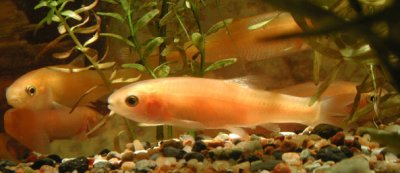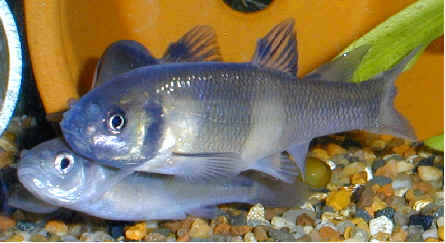
Reproduction/Life History
Fatheads begin to breed at about 6 months old, and females are at their prime at about 1 year old. Males mature a little later, peaking often in their second year. Maximum size (around 3 inches) is usually achieved at two years of age for both sexes. The exact age of maturity depends on temperature, crowding level, and water conditions as with most animals. They live from 1 to 3 years in tanks but less in ponds with predators.
Mature males stake out territories
when the temperature is between about 65 to 85 degrees F. Fatheads
breed from late Ap ril into early September in Zone 6/7
of the USA. They prefer rocks, logs, hard leaves, or other hard
surfaces. They use the undersides of rocks and plants,
mostly using the leaves of rocks. Egg-laden females are allowed access where spawning takes place. All
other fish, especially other male minnows and females devoid of
eggs, are driven away. Two breeding males may get in quite a tussle
with head shoving but do not really bite. They can however exhaust
each other. Also, females take advantage and eat the eggs if the
males get caught up in fighting.
ril into early September in Zone 6/7
of the USA. They prefer rocks, logs, hard leaves, or other hard
surfaces. They use the undersides of rocks and plants,
mostly using the leaves of rocks. Egg-laden females are allowed access where spawning takes place. All
other fish, especially other male minnows and females devoid of
eggs, are driven away. Two breeding males may get in quite a tussle
with head shoving but do not really bite. They can however exhaust
each other. Also, females take advantage and eat the eggs if the
males get caught up in fighting.
Often, the presence of another male makes a male more willing to breed than if he were the only male. I guess the competition gets their hormones flowing. Sometimes, the presence of a male with breeding experience seems to help an un-experienced male figure out what to do. So, if a solitary young pair are not breeding, try adding another male (preferably older).
During spawning, the male pushes the female's rear up onto the hard surface. She deposits eggs on the pot, etc. while he expels sperm. She may return half a dozen times during one day before being emptied. After this, it takes her about 1-3 weeks to be ready to lay eggs again. Multiple females may visit the male and leave their eggs. Thus, a "lucky" male may have a nest
with eggs at all stages of development. The male takes over duty of
the eggs. He defends them and fans them to keep water flowing over
them. He will also remove unfertilized and/or fungused eggs. After
about 5 days near 75 degrees F, the eggs hatch. The fry lay around
on the bottom and sides of the tank or pond for a few days. Then,
they swim at the surface, at the brightest spot looking for
microorganisms to eat. Infusuria, paramecium, cyclops, and newborn
brine shrimp are all good foods to feed during the first few weeks.
The fry can eat exclusively baby brine shrimp after a few weeks if
so desired. Depending on temperature and water volume and
conditions, the fry will begin eating fish food flakes and other
prepared foods as soon as they are large enough to bite at them.
nest
with eggs at all stages of development. The male takes over duty of
the eggs. He defends them and fans them to keep water flowing over
them. He will also remove unfertilized and/or fungused eggs. After
about 5 days near 75 degrees F, the eggs hatch. The fry lay around
on the bottom and sides of the tank or pond for a few days. Then,
they swim at the surface, at the brightest spot looking for
microorganisms to eat. Infusuria, paramecium, cyclops, and newborn
brine shrimp are all good foods to feed during the first few weeks.
The fry can eat exclusively baby brine shrimp after a few weeks if
so desired. Depending on temperature and water volume and
conditions, the fry will begin eating fish food flakes and other
prepared foods as soon as they are large enough to bite at them.
Reproduction of the fathead minnow is in more detail at
www.fishpondinfo.comNext, we learn how these species interact with other species.
Fathead Minnow Home University of Wisconsin LaCrosse multipleorganisms.net